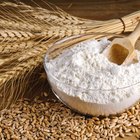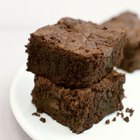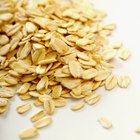
A healthier diet doesn't necessarily mean cutting out every food except the ones that are unequivocally good for you. Even small changes and choices can have a large cumulative effect. For example, consider cakes. Baking from scratch instead of a mix takes time, but cuts down on additives and preservatives. Using unbleached flour eliminates bleaching residues, or you can go further and use whole wheat pastry flour in your cakes.
A Flour Primer
Modern wheat flours are ground on a system of high-speed steel rollers. The grains are cracked, the bran and the oily and perishable germ are removed, and the remainder of the grain is processed to a fine powder. Most flours are then bleached with chlorine or hydrogen peroxide, to whiten them and improve their baking qualities, and vitamin C is added as an antioxidant. Unbleached flours are left to age and become paler naturally, and don't contain the chlorine residues found in bleached flours. In either case some nutrients are lost in milling, so vitamins are usually added back to American-milled flours.
Whole Wheat vs. White
In commercial mills, whole wheat flours are made by recombining the ground wheat with the germ and bran that were removed in the earlier stages of milling. Stone-ground whole wheat is made the traditional way, by grinding entire grains of wheat between massive stones and bagging the result. Both kinds of whole wheat flour are lower in gluten than white flour and contain flakes of bran that cut gluten strands as the dough is mixed. This means breads made from whole wheat flour tend to be denser and heavier than their white counterparts. However, for cake-making it's better to have less gluten.
Whole Wheat in Cakes
Breads are supposed to be chewy, so they benefit from flours that are rich in gluten-forming proteins. Cakes need a more delicate, softer crumb, so the lower percentage of gluten in whole wheat flour is a plus. Unfortunately, all-purpose whole wheat flour also has a stronger flavor and coarser texture, which makes it unsuitable for many types of cakes. Whole wheat pastry flour is a better option, in most cases. It's ground more finely, producing a milder flavor and a more delicate crumb.
Using Whole Wheat Pastry Flour
You can use whole wheat pastry flour as a direct substitute for unbleached flour in any cake recipe, but it's not always appropriate. For example it wouldn't be the best choice for a light and delicate angel's food cake, where the fine texture and white color are the cake's distinguishing characteristics. Whole wheat pastry flour is better used in cakes with a strong flavor, such as chocolate or spice cakes, or in butterscotch or golden cakes where its nuttiness will complement the flavor of the cake. To minimize the risk of off flavors, keep your flour in an airtight container in your fridge. The oils from the wheat germ are perishable and will become rancid over time if it's not refrigerated.
Related Articles
Is Unbleached Flour the Same as ...

Differences Between Bleached Flour & ...

What Additives Are in Flour?

What Kind of Oil Do You Use in Brownie ...
Does Cake Flour Contain Baking Soda & ...

What Kind of Flour to Use for Cupcakes?
Can You Substitute Whole-Wheat Pastry ...

Bread Flour vs. Cake Flour in Sponge ...

Does Flour Get Old or Go Bad?
What Kind of Flour Do You Use for a ...

Chemicals in Enriched Flour

Purpose of Rolled Oats in Baking
Should Cake Flour Be Sifted Before ...

Do You Still Need Baking Powder & Salt ...

What Are the Functions of Flour in ...
Can I Grind Quinoa?

Alternative Flours to Make Pizza

Can I Substitute Bleached for ...

Is Teff Flour Gluten-Free?

How Do Different Types of Flour Affect ...
References
- On Food and Cooking: The Science and Lore of the Kitchen; Harold McGee
- The Cook's Thesaurus: Wheat Flours
Writer Bio
Fred Decker is a trained chef and certified food-safety trainer. Decker wrote for the Saint John, New Brunswick Telegraph-Journal, and has been published in Canada's Hospitality and Foodservice magazine. He's held positions selling computers, insurance and mutual funds, and was educated at Memorial University of Newfoundland and the Northern Alberta Institute of Technology.
Photo Credits
Jupiterimages/Pixland/Getty Images